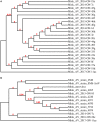Detection of Astrovirus, Rotavirus C, and Hepatitis E Viral RNA in Adult and Juvenile Farmed Mink (Neovison vison)
- PMID: 29974054
- PMCID: PMC6020771
- DOI: 10.3389/fvets.2018.00132
Detection of Astrovirus, Rotavirus C, and Hepatitis E Viral RNA in Adult and Juvenile Farmed Mink (Neovison vison)
Abstract
Mink astrovirus (MiAstV) is known to play a major role in mink pre-weaning diarrhea, and rotavirus and hepatitis E virus (HEV) are both considered potentially zoonotic agents. These viruses are not monitored in commercial mink, and the role of these viral infections in mink health is not well understood. This study assessed the prevalence of mink astrovirus, rotavirus C, mink HEV and swine HEV in 527 pooled healthy adult female mink and mink kit fecal samples from 50 Canadian mink farms in two seasons over 4 years. Viral RNA was extracted and amplified in RT-PCR to detect mink astrovirus and HEV RdRp genes, swine HEV ORF2, and rotavirus C VP6 gene. At least 26% of all positive samples for each virus was sequenced for phylogenetic analysis. Fourteen percent of samples were astrovirus positive, while 3 and 9% of samples were rotavirus C and mink HEV positive, respectively. One adult female sample was found to be positive by PCR for swine HEV. A significantly higher number of kit samples were astrovirus- and HEV-positive compared to adult female samples (p = 0.01 and p < 0.0001, respectively). Astrovirus was detected in significantly more summer samples from adult females compared to winter samples from adult females (p = 0.001). The detected sequences were closely related to previously reported MiAstV, swine rotavirus C, and mink and swine HEV strains. Two astrovirus sequences were distantly related to all other detected sequences as well as previously reported MiAstVs. These results demonstrate low to moderate prevalence of the three viruses in feces from clinically healthy Canadian commercial mink, and suggest that further monitoring of these viruses may provide a better understanding of how these potentially zoonotic agents may play a role in mink enteritis and overall productivity.
Keywords: astrovirus; commercial mink; fecal virus detection; hepatitis E virus; rotavirus.
Figures




Similar articles
-
Prevalence of lapine rotavirus, astrovirus, and hepatitis E virus in Canadian domestic rabbit populations.Vet Microbiol. 2017 Sep;208:146-149. doi: 10.1016/j.vetmic.2017.07.015. Epub 2017 Jul 17. Vet Microbiol. 2017. PMID: 28888629
-
Survey of Canadian retail pork chops and pork livers for detection of hepatitis E virus, norovirus, and rotavirus using real time RT-PCR.Int J Food Microbiol. 2014 Aug 18;185:33-40. doi: 10.1016/j.ijfoodmicro.2014.05.006. Epub 2014 May 14. Int J Food Microbiol. 2014. PMID: 24929681
-
RT-qPCR assay for detection of mink astrovirus in outbreaks of diarrhea on Danish mink farms.PLoS One. 2021 May 26;16(5):e0252022. doi: 10.1371/journal.pone.0252022. eCollection 2021. PLoS One. 2021. PMID: 34038467 Free PMC article.
-
Prevalence of fecal viruses and bacteriophage in Canadian farmed mink (Neovison vison).Microbiologyopen. 2019 Jan;8(1):e00622. doi: 10.1002/mbo3.622. Epub 2018 Apr 10. Microbiologyopen. 2019. PMID: 29635866 Free PMC article.
-
Potential zoonotic swine enteric viruses: The risk ignored for public health.Virus Res. 2022 Jul 2;315:198767. doi: 10.1016/j.virusres.2022.198767. Epub 2022 Apr 12. Virus Res. 2022. PMID: 35421434 Review.
Cited by
-
Reservoirs of Porcine Circoviruses: A Mini Review.Front Vet Sci. 2019 Sep 19;6:319. doi: 10.3389/fvets.2019.00319. eCollection 2019. Front Vet Sci. 2019. PMID: 31616677 Free PMC article. Review.
-
Acquired Bacterial Resistance to Antibiotics and Resistance Genes: From Past to Future.Antibiotics (Basel). 2025 Feb 21;14(3):222. doi: 10.3390/antibiotics14030222. Antibiotics (Basel). 2025. PMID: 40149034 Free PMC article. Review.
-
Trends and Challenges in the Detection and Environmental Surveillance of the Hepatitis E Virus.Microorganisms. 2025 Apr 26;13(5):998. doi: 10.3390/microorganisms13050998. Microorganisms. 2025. PMID: 40431171 Free PMC article. Review.
-
Mink is an important possible route of introducing viral respiratory infections into the human population.Vet Med Sci. 2023 Jul;9(4):1949-1950. doi: 10.1002/vms3.1177. Epub 2023 Jun 12. Vet Med Sci. 2023. PMID: 37307101 Free PMC article. No abstract available.
-
The Current Host Range of Hepatitis E Viruses.Viruses. 2019 May 17;11(5):452. doi: 10.3390/v11050452. Viruses. 2019. PMID: 31108942 Free PMC article. Review.
References
LinkOut - more resources
Full Text Sources
Other Literature Sources
Research Materials

